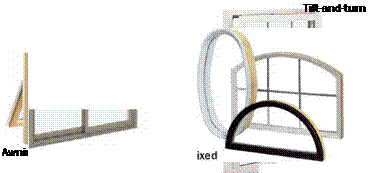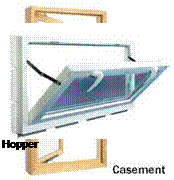Self-Cleaning Windows Reduce Maintenance Demands
For those of you who say, "I don’t do windows," technology has finally caught up with your sentiment. Several big glass companies market coated glass that resists the buildup of dirt. Product names include Neat® Glass by Cardinal, Activ™ by Pilking – ton®, and PPG’s SunClean®.
By making the glass smoother and hydrophilic, rainwater collects in sheets on the surface and slides off the glass quickly, cleaning the window. Some windows include a titanium-dioxide layer that reacts with UV – light to help organic materials decompose, so dirt washes away more easily.
Window Styles
Traditional window composed of two sashes that slide vertically. A single-hung window looks identical, but the top sash is fixed.
Pros: Available with a wide variety of grille patterns to match different architectural styles.
Sashes usually tilt in for easy cleaning of the exterior.
Cons: Sashes rely on draftier sliding-style weatherstripping. The bottom edge of the upper sash is exposed to outdoor temperatures on two faces, increasing surface area for thermal bridging. Two sashes increase spacer area, increasing U-factor. Less than half the window area can be open for ventilation.
 |
 |
Top-hinged window that usually opens outward with a crank.
Pros: Good-sealing compression-style weatherstripping. Single glass unit and recessed sash improve U-factor. Provides ventilation while it’s raining. Often used above and/or below large fixed windows for ventilation and additional daylight.
Cons: Screen on inside of window. Open window can present a hazard if installed along a walkway, deck, patio, or porch.
Dual-action window that can swing in like a door or tilt from the bottom like a hopper window for ventilation.
Pros: Ventilation options. Secure multipoint locking. Compression weatherstripping. Large egress area and easy cleaning.
Cons: Shades and drapes can interfere with operation.
Side-hinged window that usually opens outward with a crank. In-swing versions are available.
Pros: Compression-style weatherstripping. Single large glass unit and recessed sash im
prove U-factor. Largest ventilation area of any window style. Opening can be oriented to "scoop" prevailing breeze.
Cons: Screen on inside of window. Hinge design might not allow outside of window to be cleaned from inside. Open window can present a hazard if installed along a walkway, deck, patio, or porch.
The two sashes slide past one another on tracks like a sliding patio door.
Pros: Can be easier to open than other sliding styles, especially when placed over a counter.
Cons: Sliding weatherstripping and greater sash area lower U-factor and airtightness ratings.
An inoperative window available in shapes that match operable windows, or as accent windows such as half-rounds to create Pal- ladian windows and octagons.
Pros: Improved airtightness. Can be made in nonstandard, custom shapes.
Cons: Doesn’t satisfy egress requirements.
Tilt-in bottom-hinged window.
Pros: Compression-style weatherstripping. Single glass unit and recessed sash improve U-factor.
Cons: Hazardous if installed at head height or lower.
You have three choices for replacing existing windows: a sash-only replacement; an insert-style frame and sash replacement window; or a new-construction window.
If the existing frames have water damage, the only choice is a new-construction window (see the photos on p. 92).
If you’re looking to improve comfort or energy performance, replacing the sashes or using a frame insert can help. They’re a good choice on older homes where you want to preserve period trim, but from an energy and comfort standpoint, they’re not the best option.
Replacement windows that leave the existing frame in place don’t stop air leakage. If you’ve ever pulled out an old window, then you’ve seen fiberglass insulation stuffed between the window and the rough opening. Typically, the insulation is dirty. It wasn’t dirty when it was put there; dirt was filtered out of the air moving through and around the window frame.
Another negative is that insert-style frame and sash replacement windows reduce the glass area because the unit fits inside the existing frame. You might be willing to live with diminished views, but are you willing to pay for that privilege every year? In a southern climate, the reduced glass area does not affect heating bills, but in northern heating climates, reducing the south-facing glass area gives away a lot of free heat.
An insert-style frame and sash replacement window is generally a bit pricier than a
new-construction window. Installation costs are lower, however, because it leaves the existing trim in place and doesn’t require any siding removal.
Regardless of the type you choose, replacement windows are expensive. If you’re trying to save on energy expenses, new windows shouldn’t be considered until you have improved the insulation and the air-tightness of the rest of the building envelope.
Former Fine Homebuilding editor Sean Groom is a
![]()

 freelance writer in Bloomfield, Conn.
freelance writer in Bloomfield, Conn.
|
replacement |










Leave a reply